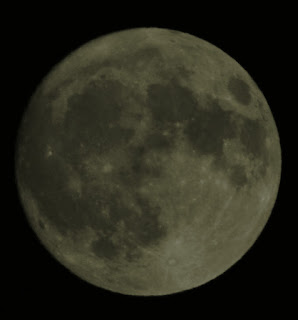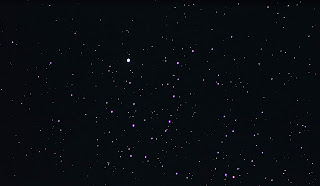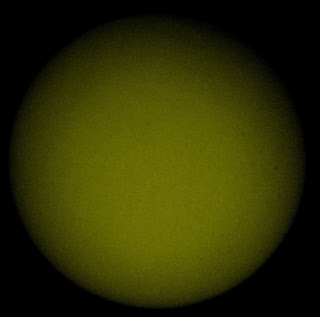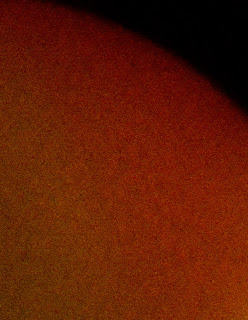December 30th 0040 GMT Betelguese
I had heard rumours that Betelguese (the red giant star in Orion) had recently halved in brightness. I had even seen it written that it made the constellation look very strange. I took a look while taking a break from driving and had a good look. The constellation looked normal enough to me but Betelguese was definitely fainter than Pollux (magnitude 1.12) but was brighter than Bellatrix and Castor (both about magnitude 1.6). This resulted in my magnitude estimate of 1.2, the faintest I had ever seen it.
December 23rd 0755 GMT Morning Moon
I caught the thin waning crescent moon in my binoculars. I saw a surprisingly large number of craters but could not see the lava-filled crater Grimaldi. Libration had probably taken it away from the illuminated part of the disc.
December 22nd Evening
The sky was partially cloudy. I made several attempts to see some Ursid meteors, with the evening being the expected peak. Due to the air humidity, I did not attempt and photographic scan. I did not see any meteors at all in a total watch time of about an hour.
December 21st 0910 GMT Moon
It
was surprisingly clear, given the recent weather but I saw the thin waning
crescent moon in the south west. I took some shots with my DSLR at 300mm focal
length, ISO 400 and 1/500 second exposure.
December 20th 2110 GMT Bin Browse
One thing I had simply not done for weeks is look at something, rather than photograph it. With a lot of cloud around and a very damp atmosphere, photography was not easy and my chances of getting anything better than I already had was simply not going to happen.
Fortunately, many deep sky objects were on display and I took my 15x70 binoculars out. The Pleiades (M45) were well-placed and I could see about 30 of them. Although the Hyades were visible, I had to move the binoculars left, right, up and down to see the whole cluster. There was too much cloud around Gemini to see the open cluster M35 but I saw Alcor and Mizar low in the north east.
Despite the haze, the Orion Great Nebula (M42) showed its familiar butterfly shape. There was not anything else on show, being clouded out to greater or lesser extents but it was nice to see something for a change.
December 17th 2020 GMT Meteor Hunt
I
wanted to catch some late Geminids but there was a lot of haze in the area. As
there was no moon, I set the camera to 16mm focal length, ISO 6400 and 8
seconds exposure, as usual. I aimed the camera in the general direction of
Taurus instead.
I did not catch any meteors but stacked 30 frames to catch the Taurus star clusters and the constellation of Auriga.
December 15th 0130 GMT Moon
There
had been heavy rain showers during the day and evening but there was a clear
period for a few minutes early morning. I snapped the Moon with my DSLR at
300mm focal length, ISO 100 and 1/800th second exposure. I waited a
few minutes, hoping to see a Geminin shower meteor but did not see any before
it clouded over again.
December 13th 2315 GMT Moon
The Moon was just past full and there was a rugged terminator showing lots of craters on the western limb. The sky was partially clear but few stars were visible and even the Moon was lost to cloud soon after.
December 11th 2040 GMT Moon
The Moon was full and thin cloud was scattering its light. I used my DSLR at 300mm focal length, ISO 100 and 1/1000 second exposure.
December 10th 2240 GMT Moon
After
an appallingly wet day, it cleared enough for a moon shot. I used my DSLR at
300mm focal length, ISO 100 and 1/500 second exposure.
December 23rd 0755 GMT Morning Moon
I caught the thin waning crescent moon in my binoculars. I saw a surprisingly large number of craters but could not see the lava-filled crater Grimaldi. Libration had probably taken it away from the illuminated part of the disc.
December 22nd Evening
The sky was partially cloudy. I made several attempts to see some Ursid meteors, with the evening being the expected peak. Due to the air humidity, I did not attempt and photographic scan. I did not see any meteors at all in a total watch time of about an hour.
December 21st 0910 GMT Moon
December 20th 2110 GMT Bin Browse
One thing I had simply not done for weeks is look at something, rather than photograph it. With a lot of cloud around and a very damp atmosphere, photography was not easy and my chances of getting anything better than I already had was simply not going to happen.
Fortunately, many deep sky objects were on display and I took my 15x70 binoculars out. The Pleiades (M45) were well-placed and I could see about 30 of them. Although the Hyades were visible, I had to move the binoculars left, right, up and down to see the whole cluster. There was too much cloud around Gemini to see the open cluster M35 but I saw Alcor and Mizar low in the north east.
Despite the haze, the Orion Great Nebula (M42) showed its familiar butterfly shape. There was not anything else on show, being clouded out to greater or lesser extents but it was nice to see something for a change.
December 17th 2020 GMT Meteor Hunt
I did not catch any meteors but stacked 30 frames to catch the Taurus star clusters and the constellation of Auriga.
December 15th 0130 GMT Moon
December 13th 2315 GMT Moon
The Moon was just past full and there was a rugged terminator showing lots of craters on the western limb. The sky was partially clear but few stars were visible and even the Moon was lost to cloud soon after.
December 11th 2040 GMT Moon
The Moon was full and thin cloud was scattering its light. I used my DSLR at 300mm focal length, ISO 100 and 1/1000 second exposure.
December 10th 2240 GMT Moon
December 9th 2100 GMT Moon and Meteor Hunt
The waxing gibbous moon was bright, so I used my DSLR at
300mm focal length, ISO 100 and 1/400 second exposure.
I did not catch any meteors but I stacked a few images to capture the constellation of Gemini.
December 8th 1930 GMT Moon
It was an awful day but a small gap appeared to let me catch
the Moon.
December 6th 1800 GMT Moon
December 4th 1705 GMT
Venus was low in the south west. I took some shots with my
DSLR at 300mm focal length and auto. I would not expect it to show much detail,
even in a powerful telescope, as it was near its furthest distance from Earth.
I caught it against the background.
I
also shot the Moon at 300mm focal length, ISO 100 and 1/200 second exposure.
December 3rd 2130 GMT
I repeated the lunar shot with the same settings as the day before.
December 2nd 1805 GMT Moon
December 2nd 1635 GMT Venus
I
noticed Venus low in the south west while driving home from work. It was my
first sighting since superior conjunction.
December 1st 2000 GMT The Moon
I tried to snap the Moon with my DSLR but it was too low down and I could not get a clear image.































































